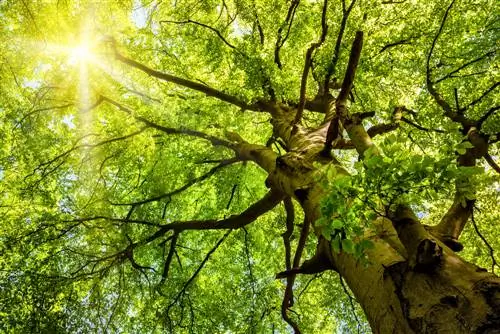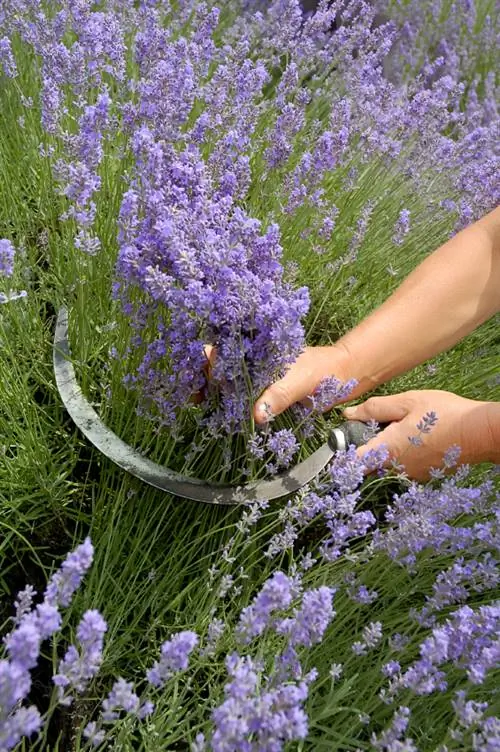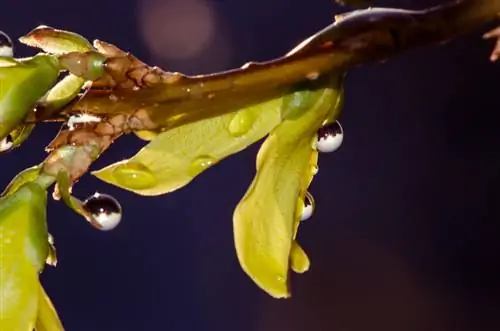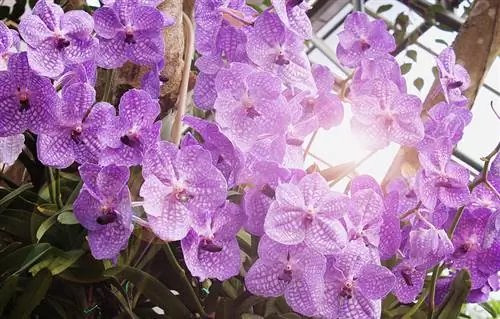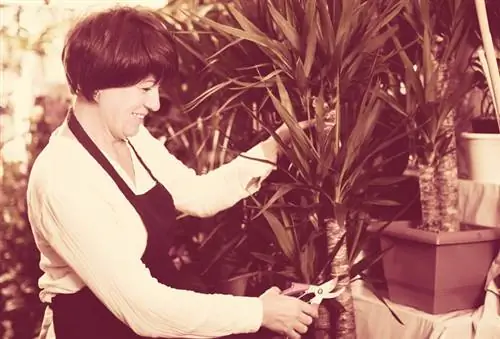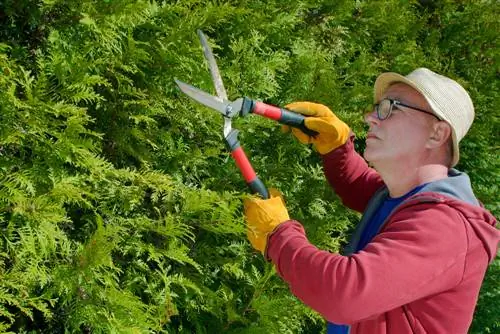- Author admin [email protected].
- Public 2023-12-29 04:51.
- Last modified 2025-01-23 11:22.
The tree crown towers over the trunk and forms essential basic organs for the survival of a tree. It provides people with shade, fruit and spiritual fulfillment. You can find out practical and romantic things about treetops from cutting to poems in this article.
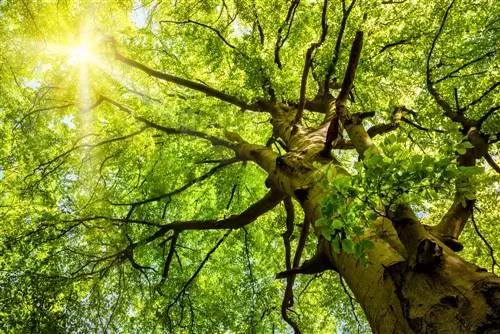
What is the treetop and what function does it have?
The crown is the uppermost part of a tree and consists of the trunk, branches, twigs and leaves. In botany it is essential for the metabolism and transport of nutrients and water. Tree crowns can vary in shape and features and are maintained by pruning for fruit and ornamental trees.
Botanical definition of the tree crown
From a botanical perspective, the tree crown is the part of a tree that is usually divided into branches, twigs and leaves from the trunk. The branches and twigs serve as part of the shoot axis to supply nutrients, water and assimilates absorbed via the roots to the leaves. As one of the basic organs of the tree, these ensure the metabolism of the energy absorbed through photosynthesis and transpiration.
Depending on the tree species, tree crowns can have very different shapes and features. An important criterion is of course the distinction between leaves and needles, which is initially visually noticeable to humans. Biologically, needle leaves in trees are a sober adaptation, especially to dry environmental conditions, which can be cushioned by the reduced leaf surface and the thick cuticle.
In terms of habit, tree crowns vary between lush, sprawling and narrow, tall forms, which also depend on environmental conditions such as light and space availability and temperature.
Treetops from the gardener's perspective

Tree crowns are pruned for various reasons
In the wild, trees can easily manage their own crowns. In order to maintain their practical functions, they generally do not need any help from humans. After all, care measures in the form of pruning by humans primarily serve the economic and/or aesthetic use of the tree.
When pruning tree crowns, a distinction must first be made between two categories, each of which relates to different tree species and different objectives:
1. Crop tree pruning for higher fruit yield2. Ornamental tree pruning for more lush flowers and shapeliness
The pruning of commercial trees - and when it comes to tree crown pruning we are of course referring to fruit trees - has primarily an economic purpose, while with ornamental trees the aesthetic appearance for enjoyment is in the foreground.
There are different techniques for both types of treetop pruning, each with slightly varying interests. Let's take a closer look at the most important ones.
Cutting tree tops
In this section, let us first turn to fruit tree pruning and then to ornamental tree pruning.
Fruit tree pruning
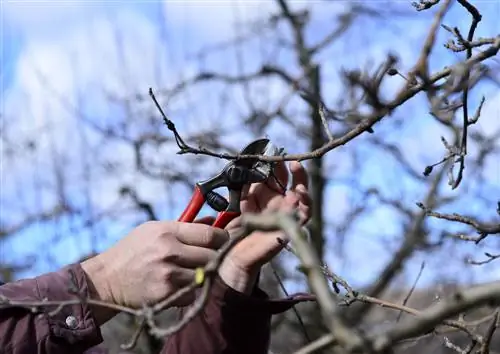
The crowns of fruit trees are pruned to increase yield
The aim of pruning fruit trees is to achieve a lush and aromatic fruit yield and a good balance between growth, flower and fruit formation over the entire lifespan. For this purpose, some basic knowledge about the effects of cutting activities is useful. Basically the following things apply:
- Completely cutting off shoots (i.e. at or behind the base) transfers growth power to the existing twigs and branches, while cutting them off before the base stimulates new branching
- The amount of pruning depends on the growth rate of the tree species, the age and the rootstock
- Time of cutting is based on growth rate
The base of a branch always forms a clear boundary to a new section. This means that the tree's energy flow can be specifically controlled by the location where the shoots are cut. If you cut a shoot at or behind the point of attachment, the energy returns to the older parts of the crown. However, if you cut off the shoot before the point of attachment, it remains in the young wood and stimulates new shoots, which will later require more corrective cuts.
Depending on the type of fruit, the age of the individual and the type of rootstock in grafted trees, fruit trees grow at different rates. Slow-growing fruit trees or rootstocks such as apples or quinces are generally easier to prune and do not need to be constantly kept in check. However, species that shoot up quickly and/or branch out easily, such as pears, sweet cherries or plums, need to be pruned more frequently and, if possible, in the summer after the harvest in order to curb their growth and provide more light by removing excess shoots.
How to prune depends on the phase a fruit tree is in. In relation to these phases, there are 4 cutting methods:
1. Plant cutting
2. Parenting cut
3. Conservation cut4. Rejuvenation cut
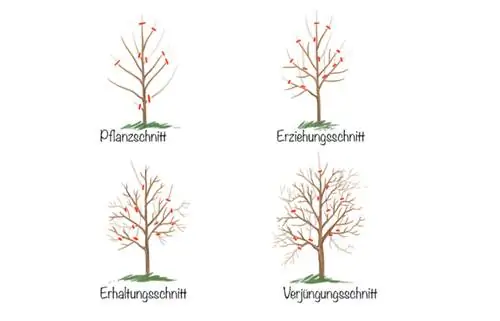
| Plant cutting | Educational Cut | Conservation cut | Rejuvenation cut | |
|---|---|---|---|---|
| In which phase of life? | After planting | Growing up | In mature, regularly fruiting stage | In old age, after years of lack of care |
| Season | In the first spring | Annually in winter, possibly also in summer | Annual in winter | One time/if required in spring |
| Purposes | Specify first shaping direction | Promote a sustainable, balanced crown | Maintain shape and ensure balanced fruit yield | ‘Cancellation’ of rewilding, revitalization |
| Measures | Remove lower and competing shoots from the middle shoot | Short the central shoot and main side branches, remove inner and vertical shoots | Remove internal and vertical shoots as well as old wood, | Remove old wood generously, followed by water jets as well |
Plant cutting
When pruning, it is important to give the crown of the fruit tree an initial direction after planting. To do this, in the spring, the unnecessary shoots in the lower area that are not intended to be part of the future crown are removed. In the part of the crown that you want to preserve, select a central shoot that is as central and vertical as possible and remove competing, strong secondary shoots. In addition, all remaining shoots are shortened so that they are approximately the same length and an overall balanced nutrient supply is promoted.
Educational Cut
The goal when pruning a young tree is to build a stable, well-ventilated and light-supplied crown structure. The training cut is carried out once a year in winter, and for fast-growing varieties also in the summer after flowering or after the harvest when the tree has reached the age of fruiting. In this phase, the central shoot can be shortened a little to strengthen it. Otherwise, all shoots growing inwards are removed and the balanced main branches are shortened, also to strengthen them.
Conservation cut
If the fruit tree has reached a stable, middle age in which it regularly produces fruit that is balanced in terms of quantity and aroma, this should be preserved. To do this, remove all inward/vertically growing shoots and older, heavily branched outer shoots that only bear a few fruits every winter.
Rejuvenation cut
As they get older, fruit trees can use a rejuvenation cut every now and then. Even individuals who have not been cut for years can be brought back up to speed. However, a rejuvenation cut is not an entirely trivial matter and challenges even professional fruit growers. A rejuvenation cut is characterized by the fact that a lot of old branch material and parasites such as mistletoe or light-eaters such as ivy are removed, which significantly disrupts the tree's established balance. If necessary, an expert should be consulted.
Basically, a rejuvenation cut is carried out in spring. All old, heavily branched branches are removed, so that only selected, vital branches remain in a balanced distribution. Over the course of the season, the tree will respond to the removal of large main branches by forming vertical shoots of water, which should be removed immediately. The following year after rejuvenation, you return to maintenance pruning.
Ornamental tree pruning
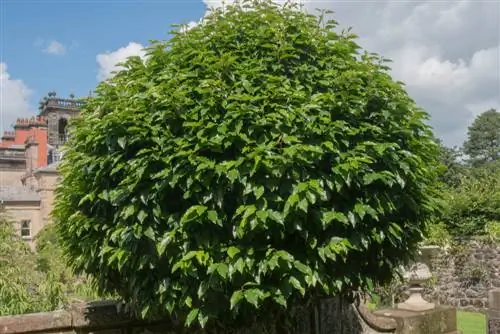
Ornamental trees are often cut into shape
Ornamental trees are kept for aesthetic enjoyment, which is why pruning measures on them are intended to maintain the abundance of flowers and attractive growth habit.
When pruning ornamental trees, less is often more
In general, pruning ornamental trees is a little less military than pruning fruit trees. For most species, you don't have to use pruning shears every year and you are also a little more flexible when it comes to the time of year. In addition, you should be cautious about cutting some ornamental trees anyway. The natural growth pattern is often particularly attractive and can degenerate into a lack of character if it is cut too meticulously. Especially with popular ornamental trees such as the Japanese maple, magnolias or ginkgo trees, the full treetop charisma often only develops with age - so it is worth patiently holding back before intervening.
Consider cutting compatibility
Apart from the naturally developing aesthetics of the tree crown shape, one should also be careful with regard to the pruning tolerance of ornamental trees. Because some people don't like being cut back at all and react to it with very hesitant re-growth. You should especially leave coniferous trees to their own devices, but rowan trees, vinegar trees and golden maples would also prefer to remain untouched. Species that like to grow and shoot, such as ornamental apples, ornamental cherries, hawthorn and hawthorn and especially rose trees, can easily be trained to form dense crowns.
Promote flowers
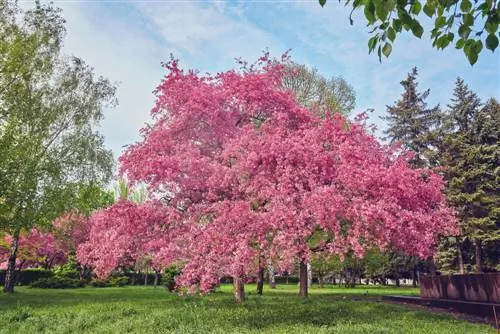
Promoting flowers is another goal of tree pruning
In addition to shape training, promoting flowering is an important concern when pruning ornamental trees. In order to be successful here, you have to choose the right time. Especially if you cut too late, you can literally nip the entire upcoming bloom in the bud. Basically, spring bloomers are cut after flowering, summer bloomers in winter or early spring.
Care for the treetop
In order to keep the shape of an ornamental tree crown attractive and to promote he althy, balanced growth, thinning is necessary from time to time. Similar to maintenance pruning of fruit trees, you primarily remove the shoots that grow inwards and vertically. This means that the remaining branches and twigs get more light and air and the nutrients are distributed more evenly.
Growing ornamental trees also need their crowns reduced every now and then. It is important to maintain the natural growth habit. This can be achieved by shortening only the longest main branches directly above the base of one of its side shoots, rather than simply 'shaving' everything from the outside to a uniform length.
Educate treetop shape
When the crowns of ornamental trees are shaped, they are usually spherical. Varieties that naturally form a densely branched crown and therefore often have the prefix 'Kugel-' in front of their species name are suitable for this purpose - such as spherical maple, spherical locust or spherical trumpet tree. But hawthorn and hawthorn are also popular and suitable candidates for growing the crown of a ball tree.
The cut to create a geometrically accurate ball is made every 2-3 years in winter, only moving the cut on the shoots outwards a little at a time in order to keep the cutting injury to a minimum.
The treetop as a mystic and spiritual inspirer

Treetops also play a role again and again in poems and literature
Finally, a few words about the great romantic role that treetops have always played for people. Their majestic power, their whispering noise, their swinging vitality, refreshing shade and protection from wind and weather are sweet, sensory gifts that have always inspired people in all regions of the world and cultures to poetic, mystical and religious glorification. Entire religious concepts are based on plants and in particular on trees, and in poetry the treetops that provide comfort, shade, joy and beautiful eerieness are protagonists countless times.
Our great poet Schiller expresses eloquently the individual absorption through the beauty, the unfathomable majesty and mysterious connection of treetops:
Excerpt from: The Walk by Friedrich Schiller, 1795:
But now it roars from the nearby bushes, The alder crowns bend low, And the silvered grass waves in the wind.
The ambrosial night surrounds me: in fragrant cooling
A magnificent roof of shady beech trees captures me, In the secret of the forest, the landscape suddenly escapes me, And a winding path leads me upwards.
Only the branches ste althily penetrate the leafy lattice
Economical light, and the blue looks in, laughing.
But suddenly the pile tears. The opened forest gives me back Surprisingly, the dazzling splendor of the day.
faq:
How exactly is the tree crown defined?
The tree crown is the part of the shoot axis of a tree that goes from the trunk into the branches, twigs and leaves. It is used for nutrient and water transport as well as metabolism.
How do I cut the crown of a fruit tree?
When pruning fruit trees, it is important to promote as much fruit yield as possible and to keep the tree he althy and young. Depending on the phase of life, fruit trees are made with planting cuts, training cuts, maintenance cuts or rejuvenation cuts. When pruning, you give a newly planted fruit tree the basic direction for the crown shape. When pruning, you promote the selected main branches in order to get a stable crown. Maintenance pruning serves to maintain good crown ventilation and light and thus a regular fruit yield. With a rejuvenation cut you can revive old and/or overgrown specimens.
How often do I have to cut the crown of a fruit tree?
Fruit trees should ideally be pruned every year in winter. Very fast-growing species tolerate additional pruning in summer.
How to trim the crown of an ornamental tree?
For ornamental trees, you should be a little more conservative with pruning than for fruit trees. On the one hand, some varieties do not tolerate frequent pruning particularly well, and on the other hand, the natural growth habit is often extremely attractive and should not be destroyed. For species that are insensitive to cutting and tend to sprout, pruning can be carried out every few years to thin out and reduce the size of the crown. Training to create ball tree crowns is only suitable for naturally densely branching varieties.
How often is crown pruning necessary for ornamental trees?
Growing ornamental trees that tolerate pruning can be cut back and thinned out every 2-3 years. Species that are less tolerant of cutting and slow growing should, however, be left alone and only be cut if there is storm damage.

